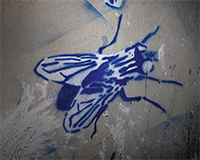 At the height of the 2009 swine flu pandemic, the Egyptian government ordered that all of the nation’s pigs – some 300,000 animals – should be slaughtered. They thought this would help to limit the spread of swine flu in dense urban environments such as Cairo. But the cull had an interesting, if all too predictable, side effect.
At the height of the 2009 swine flu pandemic, the Egyptian government ordered that all of the nation’s pigs – some 300,000 animals – should be slaughtered. They thought this would help to limit the spread of swine flu in dense urban environments such as Cairo. But the cull had an interesting, if all too predictable, side effect.
Pigs were an unofficial part of the nation’s waste-processing infrastructure. They were tacitly relied upon as a key component of the public sanitation regime, and wiping them out resulted in rapidly growing piles of organic waste in the streets.
When we think of cities, traditionally this brings to mind roads, homes and vehicles. But animals are as much a functional part of the modern city as subways and skyscrapers.
Chicago’s O’Hare Airport, one of the busiest in the world, recently turned to animals as a workforce for seasonal landscape maintenance. In 2013, the airport added what the Chicago Department of Aviation called its “O’Hare grazing herd”.
This motley crew of sheep, llamas, goats and donkeys has since been put to work as a lawn-mowing service. Indeed, the animals have proven themselves to be a cost-effective means for keeping grass and shrubs under control in spaces “that are difficult to maintain with traditional landscaping equipment”, the CDA says.
Even better, from an aviation safety perspective, it reduces the number of birds nesting near the airport’s runways, which can be a hazard if they collide with planes or get sucked into the engines.
The tactic of using animals in cities to manage or even cull other animals is surprisingly common. It is also not without its comedy. In London during the Second World War, for example, MI5 created a special falconry unit for hunting down pigeons feared to be carrying messages to German spies. However, as historian Calder Walton points out in his book Empire of Secrets, the only thing those unfortunate pigeons were guilty of was inspiring paranoia.
Dubai has made falconry a minor but dependable part of its pest-control strategy. Amid the seven-star hotels, artificial islands and skyscrapers, Saker falcons are being trained to help clear the skies of pigeons. Elsewhere, falcons are being trained with the help of drones – that is, robots are helping to domesticate animals to work for humans.
Several Californian cities have also picked up on the falconry game, incorporating animals into their urban sanitation regimes. Contractors such as Airstrike Bird Control and Pacific Coast Falconry are hired to put trained falcons to work patrolling everything from vineyards to landing strips and golf courses to parks. Even in the heart of Santa Monica, a falcon patrols a corporate business park. Birds are being used to get rid of other birds and all their associated waste – not to mention any talon-sized vermin.
What unites these examples is the way in which municipal infrastructure is being expanded to include living creatures. In many ways, of course, this is simply the contemporary urbanisation of a practice that goes back millennia. However, the ensuing juxtapositions – of 21st-century landscapes and cities being maintained not by high-tech machines or by specialist equipment but by neo-medieval groups of trained animals – can be quite jarring. Animal labour is once more becoming an explicit component of the modern metropolis, as much a part of the city as subway cleaning crews or distant landfills.
In recognising this critical infrastructural role, we must also recognise the near certainty that simply cohabiting with other animals may not be enough for the sheer scale of our urban needs. Instead, it is highly likely that we will soon engineer whole species specifically to function as permanent parts of our everyday urban infrastructure, and we must be prepared to discuss the ethical implications of this before it happens.
For US-based science writer Emily Anthes, author of Frankenstein’s Cat, this apparently futuristic vision has already happened. In her book, Anthes takes a long look at the emerging world of engineered animals.
Technologies such as genetic engineering, cybernetics and cloning will “give us all sorts of ways to make animals more useful to us”, says Anthes. “And the more useful we make animals, the more likely we are to actually use them.” Such technologies are now “allowing us to engineer new beasts of burden”, she says. “In a sense, we can turn new species, which we might never have relied on before, into tools or even service providers.”
Anthes points to the growing use of cyborg insects for search and rescue. This means sending sensor-equipped roaches deep into the rubble of a collapsed building to find survivors. But, Anthes suggests, this insect-provided service could also be useful outside the scope of a disaster scene, becoming both ubiquitous and constant.
Today, we rely on devices such as radon detectors, smoke alarms and seismographs to keep tabs on the built environment, alerting us to possible problems or looming emergencies. But, just as O’Hare Airport partially replaced its lawn-care crew with a flock of sheep, London or New York might turn to insect sensors to infest – and thus study – otherwise unreachable urban spaces. If we need more data, we just send more bugs.
From there, it is only a question of scale and, of course, that business buzzword: optimisation. Think goats bred for more efficient grass digestion used to clear our airports and highways, cyborg falcons engineered for stronger eyesight to replace CCTV, and even cyberbugs sent trundling into the streets of Manhattan to reclaim valuable recyclables from our  rubbish. The growing temptation will be to turn to engineered animals, rather than to existing equipment or inanimate machines, to perform future urban work for us.
rubbish. The growing temptation will be to turn to engineered animals, rather than to existing equipment or inanimate machines, to perform future urban work for us.
This has fantastic environmental benefits – but extraordinary ethical risks.
Geoff Manaugh is a columnist for New Scientist. This article was first printed in EG’s sister publication and is available in full at www.newscientist.com










